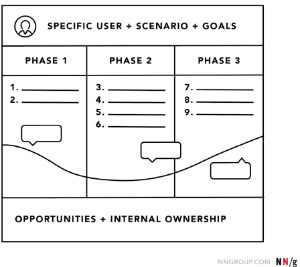Service design is the process of understanding and refining an organization’s people, processes, systems, and policies to improve both the employee experience and, directly and indirectly, the customer’s experience. I communicate to clients a simple 3 step approach to service design including:
Personas -> Journey Maps -> Service Blueprints
In Part 1 we covered the topic of Personas and the important practice of identifying, defining, and gaining empathy for the specific customers of your products and/or services. Today, in Part 2, we explore the second step of service design, which focuses on customer Journey Mapping.
Once upon a time, I fathered a wonderful girl who, at this time of writing, is four years old. My daughter’s favorite Disney movie is Cinderella. If we flash-forward to the ending of the story, Prince Charming wants to marry the unidentified maiden he met at the Grand Ball. Unfortunately, she leaves in haste before he learns her name. His only clue to her identity is that she leaves behind one glass slipper. The next day, the King sets the Duke on a mission to have the slipper fitted on every girl in the Kingdom. And of course, when the Duke places it on Cinderella’s foot, it fits perfectly!

Too often organizations focus on creating great products and services in a one-size-fits-all approach. That is, we take the time to create a great product (e.g., glass slipper) but we do not thoughtfully consider the unique customer needs and goals – will it fit? We often, like the Duke, try to forcefully stuff oversized feet into a dainty glass slipper. We seek to solve the problem rather than to first understand or reframe the problem.
You will create innovative solutions if you first develop a deep understanding of your target customers (see Part 1 – Personas). Note that I use the plural “customers” because your solution should never be one-size fits all. In fact, one way to gain empathy for your customers is by developing a customer journey map.

A customer journey map is a visual artifact representing the customer’s perspective of what their experience is like with you, the organization. This does not reflect the organization’s perspective. Rather, it is what I call an “empathy artifact” – a tool to reflect the voice of the customer. Empathy artifacts lead to businesses solving the right problem the right way, significantly increasing their return on investment for upfront costs.
Here are the basic ingredients of a good journey map:
Although we haven’t addressed how a journey map is constructed, it should go without saying that if you’ve created it without any customer research, input, and validation activities, you’ve done it wrong! A good journey map should act as the customer voice when the organization makes decisions that will impact its customers. Think of this artifact as your “Fairy Godmother” that can help usher in a fairy-tale ending for your organization.